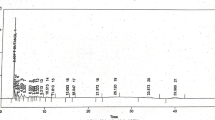Abstract
Mauritia flexuosa is a species of palm belonging to the Arecaceae family that grows in extensive area along north-central Brazil, Colombia and Venezuela. The by-products of these fruits like the oil are of great economic and social importance in all countries where it grows; the oil extracted from fruits of M. flexuosa is used for cooking and is rich in monounsaturated fatty acids and natural antioxidants; and also, recently antiplatelet activity was reported. In order to better understand the thermal behavior and the antioxidant capacity of the oil extracted from the peel of M. flexuosa, the lipid profile, TG/DTG curve (under oxygen atmospheres), total phenolic content and the antioxidant activity were determined. The TG curve of the oil extracted from the peel of M. flexuosa showed a mass loss at a temperature ranging between 200 and 600 °C. The bigger decomposition step occurred in the temperature range of 200–420 °C, showing a similar thermal behavior than the canola and olive oils. Nevertheless, the studied oil showed a higher phenolic content at a degradation onset temperature (T 0) than the other oils, and this is due to the structural characteristics of the polyphenols that have these oils. The antioxidant activity of the different oils by the DPPH radical scavenging method showed that there is a direct correlation between phenol contents and antioxidant activities of the oils. This study shows the importance of the M. flexuosa oil obtained from the peel as a potential source of natural antioxidants.




Similar content being viewed by others
References
Ferreira EL. Palm trees of acre handbook, Brazil (in Portuguese). 2008. http://www.nybg.org/bsci/acre/www1/manual_palmeiras.html. Accessed Dec 2014.
Gilbert B. Economic plants of the Amazon. In: Seidl P, Gottlieb OR, Kaplan MA, editors. Chemistry of the Amazon: biodiversity, natural products and environmental issues. ACS Symposium Series. Washington, DC; 1995. pp. 9–33.
Albuquerque MLS, Guedes I, Alcantara P Jr. Characterization of Buriti (Mauritia flexuosa L.) oil by absorption and emission spectroscopies. J Braz Chem Soc. 2005;16:1113–7.
Franc LF, Reber G, Meireles MAA, Machado NT, Brunner G. Supercritical extraction of carotenoids and lipids from buriti (Mauritia flexuosa), a fruit from the Amazon region. J Supercrit Fluids. 1999;14:247–56.
Fuentes E, Rodriguez-Pérez W, Guzman L, Alarcon M, Navarrete S, Forero-Doria O, Palomo I. Mauritia flexuosa presents in vitro and in vivo antiplatelet and antithrombotic activities. Evid Based Complement Altern Med. 2013;. doi:10.1155/2013/653257.
Zanatta CF, Mitjans M, Urgatondo V, Rocha-Filho PA, Vinardell MP. Photoprotective with Buriti oil (Mauritia flexuosa) against UV irradiation potential of emulsions formulated on keratinocytes and fibroblasts cell lines. Food Chem Toxicol. 2010;48:70–5.
Arain S, Sherazi STH, Bhanger MI, Talpur FN, Mahesar SA. Oxidative stability assessment of Bauhinia purpurea seed oil in comparison to two conventional vegetable oils by differential scanning calorimetry and Rancimat methods. Thermochim Acta. 2009;484:1–3.
Gómez-Alonso S, Fregapane G, Salvador MD, Gordon MH. Changes in phenolic composition and antioxidant activity of virgin olive oil during frying. J Agric Food Chem. 2003;51:667–72.
Cheikhousman R, Zude M, Bouveresse DJR, Léger CL, Rutledge DN, Birlouez-Aragon I. Fluorescence spectroscopy for monitoring deterioration of extra virgin olive oil during heating. Anal Bioanal Chem. 2005;382:1438–43.
Singleton VL, Joseph A. Colorimetry of total phenolics with phosphomolybdic–phosphotungstic acid reagents. Am J Enol Vitic. 1965;16:144–58.
Brand-Williams W, Cuvelier ME, Berset C. Use of a free radical method to evaluate antioxidant activity. LWT Food Sci Technol. 1995;28:25–30.
Molyneux P. The use of the stable free radical diphenylpicrylhydrazyl (DPPH) for estimating antioxidant activity. Songklanakarin J Sci Technol. 2004;26:211–9.
USDA National Nutrient Database for Standard Reference, SR-23. 2010.
Paganuzzi V. On the composition of irían olive. J Am Oil Chem Soc. 1979;56:925.
Kobelnik M, Cassimiro DL, Dias DS, Ribeiro CA, Crespi MS. Thermal behavior of jerivá oil (Syagrus romanzoffiana). J Therm Anal Calorim. 2011;106:711–5.
Kobelnik M, Cassimiro DL, Dias DS, Ribeiro CA, Crespi MS. Thermal behavior of araçá oil (Psidium cattleianum Sabine). J Therm Anal Calorim. 2012;108:1281–6.
Kobelnik M, Fontanari GG, Cassimiro DL, Ribeiro CA, Crespi MS. Thermal behavior of coffee oil (Robusta and Arabica species). J Therm Anal Calorim. 2013;. doi:10.1007/s10973-013-3150-z.
Silva Ferreira B, de Almeida CG, Pereira Faza L, de Almedia A, Galuppo Diniz C, da Silva VL, Grazul RM, Le Hyaric M. Comparative properties of Amazonian oils obtained by different extraction methods. Molecules. 2011;16:5875–85.
Cerretani L, Bendini A, Barbieri S, Lercker G. Preliminary observations on the change of some chemical characteristics of virgin olive oils subjected to a “soft deodorization” process. Riv Ital Sost Grasse. 2008;85:75–82.
Vecchio S, Campanella L, Nuccilli A, Tomassetti M. Kinetic study of thermal breakdown of triglycerides contained in extra-virgin olive oil. J Therm Anal Calorim. 2008;91:51–6.
Santos JCO, Santos IMG, Conceicão MM, Porto SL, Trindade MFS, Souza AG, Prasad S, Fernandez VJ Jr, Araujo AS. Thermoanalytical, kinetic and rheological parameters of commercial edible oils. J Therm Anal Calorim. 2004;75:419–28.
Buzas I, Kurucz E. Study of thermooxidative behavior of edible oils by thermal analysis. J Am Oil Chem Soc. 1979;56:685–8.
Dweck J, Sampaio CMS. Analysis of the thermal decomposition of commercial vegetable oils in air by simultaneous TG/DTA. J Therm Anal Calorim. 2004;75:385–91.
Garcia CC, Franco PIBM, Zuppa TO, Antoniosi Filho NR, Leles MIG. Thermal stability studies of some Cerrado plant oils. J Therm Anal Calorim. 2007;87:645–8.
Paz I, Molero M. Aplicación de la espectrofotometría UV–visible al studio de la estabilidad térmica de aceites vegetales comestibles. Grasas Aceites. 2000;51:424–8.
Acknowledgements
Jaime Gallego is grateful to the University of Antioquia and “Sostenibilidad” Program 2014–2015.
Author information
Authors and Affiliations
Corresponding author
Rights and permissions
About this article
Cite this article
Forero-Doria, O., Gallego, J., Valdes, O. et al. Relationship between oxidative stability and antioxidant activity of oil extracted from the peel of Mauritia flexuosa fruits. J Therm Anal Calorim 123, 2173–2178 (2016). https://doi.org/10.1007/s10973-015-4822-7
Received:
Accepted:
Published:
Issue Date:
DOI: https://doi.org/10.1007/s10973-015-4822-7




